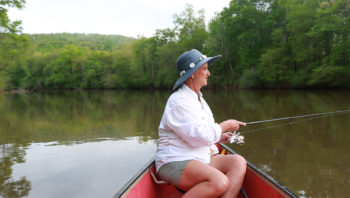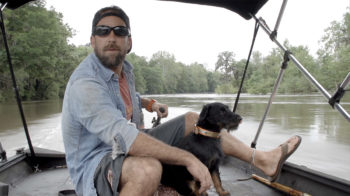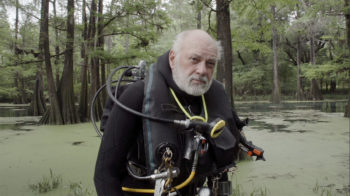We are thrilled to be traversing the Colorado River Basin, filming a new episode of the travel journal, The Wonder List with CNN. Each episode focuses on people, places, cultures, or creatures facing a crossroads. Hosted by veteran journalist Bill Weir, the show was one of the most popular shows on CNN in 2015.
Over 15 days we will be traveling to new locations, interviewing both local residents and national experts about this compelling and important region.
Follow along for updates and insights from our journey.
Updates From the Field
My passion for Southwest Oregon’s rugged and remote Kalmiopsis Country began with kayak trips down California’s North Fork of the Smith River, whose headwaters begin in the Kalmiopsis.
The reddish-brown rocks of its Redwall Canyon seem harsh from a distance, but once seen up-close, you too would be smitten by the beautiful waterfalls and unique plants. It’s this mythical spell that keeps kayakers coming back to this famed wild river.
A little to the north in Oregon, the Rogue, Chetco and Illinois Rivers are also spellbinding, but retain their own unique charm due to the surrounding lush forests and serpentine rocks that lend these rivers a mesmerizing blue-green hue. These rivers are legendary among river runners for their big rapids, clear water, and remote locations.
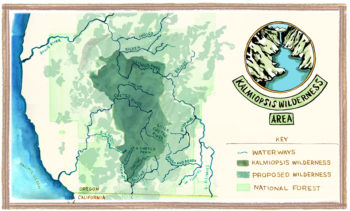
Map of the Kalmiopsis Wilderness Region
It was during exploratory trips down Rough and Ready Creek and Baldface Creek that I once again encountered the stark yet botanically rich serpentine terrain found in the North Fork of the Smith River’s Redwall Canyon. I’ve felt myself drawn back to these creeks again and again, and earlier this year, I headed out to explore some of the areas that could be forever changed if current attempts to develop nickel strip mines are successful.
Like all paddling trips in the remote and rugged Kalmiopsis Country, just getting to the river is an enormous task. We started by hiking seven miles, with kayaks and overnight gear, up the ridge that separates Rough and Ready Creek and Baldface Creek to where we camped at a small spring for the night.
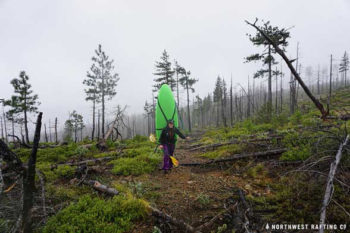
Hiking along the the ridge that separates Baldface Creek and Rough and Ready Creek, CA
Had we hiked west a couple miles down to Baldface Creek from this broad stoney ridge, we would have joined up with Oregon’s half of the famed North Fork of the Smith River.
But instead we headed east towards Rough and Ready Creek, which would eventually lead us to the upper West Fork of the Illinois River. After exploring some pretty side creeks full of Port Orford cedar and Darlingtonia californica (a type of pitcher plant), it was another grueling three miles to a campsite that overlooked the confluence of the North and South Forks of Rough and Ready Creek.
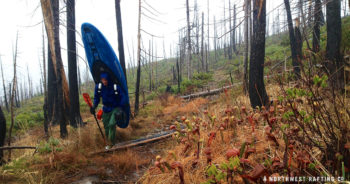
A Darlingtonia californica fen in the upper reaches of Rough and Ready Creek
The following morning we carried our boats down to the North Fork of Rough and Ready Creek where we put-in our kayaks close to where the nickel strip mines are proposed.
We paddled the creek’s Class III and IV rapids with absolute glee. As we headed down to the confluence with the South Fork of Rough and Ready Creek, we tried not to imagine how the proposed mining would devastate the stunning landscape and thriving ecosystem that nature has spent countless years perfecting. We continued down through the presently pristine water to meet the West Fork of the Illinois River.
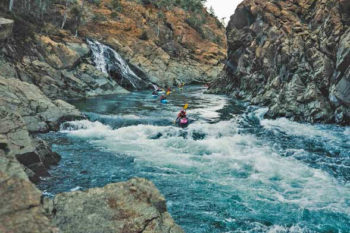
Kayaking on the North Fork Smith River
Both Baldface Creek and Rough and Ready Creek are not well-known because of their remote locales and challenging access, but it’s because of these legendary qualities that they are in desperate need of champions.
The threats posed by large-scale nickel mining would drastically harm both of these creeks as well as the rivers they feed downstream (Illinois, Rogue and Smith).
A hydraulic hammer pounding into the Centreville Dam heralds a coming new chapter for Gravel Run, a tributary to the Corsica River along Maryland’s Eastern Shore.
American Rivers is partnering with the Town of Centreville, Maryland Department of Natural Resources (DNR), U.S. Fish and Wildlife Service, and NOAA Restoration Center (NOAA) to remove the obsolete Centreville Dam and reconnect 13 miles of habitat for alewife and blueback herring, American eel, and yellow and white perch in an effort to improve their chance of survival and propagation.
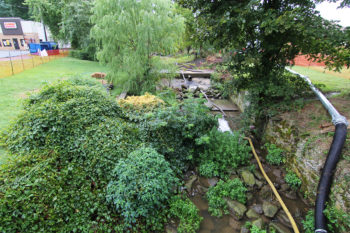
Looking upstream at the Centreville Dam. The hose on the right is part of the pump system to dewater the work area.
“The U.S. Fish and Wildlife Service has been working for several years with American Rivers, Maryland DNR, and NOAA to identify dams in Maryland that are a priority for removal due to barriers to fish passage and risk to lives or infrastructure during high water events,” said Julie Devers, a fishery biologist with the U.S. Fish and Wildlife Service.
“Centreville Dam is one of the first dams that the group identified as a priority for removal using the Chesapeake Fish Passage Prioritization decision support tool. The collaborative effort to remove the dam will provide open access for blueback herring, alewife, and American eel to upstream habitat.”
Despite its small size, the Centreville Dam also exacerbates upstream flooding on Gravel Run, threatening local businesses and the police station located along its impoundment. As climate change threatens to increase incidents of flooding, we hope to improve local flood resiliency by removing the dam and restoring the natural stream channel and surrounding habitat.
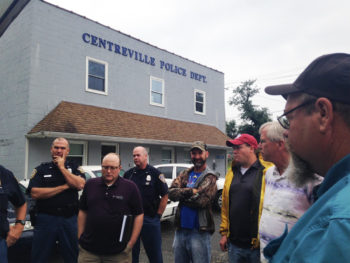
The Centreville Police Station is located right along the river, and the sheriff and his officers came out to learn more about the planned work.
River restoration at this site entails more than just removing the Centreville Dam. Sitework began in mid-August when crews installed sandbags to stem the river’s flow and pumps to dewater the work area.
They also installed a rock ramp feature downstream in order to help fish navigate a downstream utility crossing and bridge, both of which needed to stay.
After the dam is removed, we will continue excavating out the historic river channel and will shore up the vegetative buffer with trees and shrubs that will provide additional shade habitat and protection against bank erosion. This work should wrap up in the next few weeks, and the site should be worth seeing by the fall harvest.
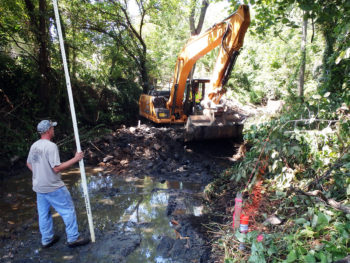
Crews excavate additional sediment out of the downstream channel as they prepare to build the rock ramp.
We would like to extend a special thanks to all of our funding partners.
We could not have made this happen without the financial support of the U.S. Fish and Wildlife Service funds from the Disaster Relief Appropriations Act of 2013 through the Department of the Interior, National Fish and Wildlife Foundation, Chesapeake Bay Trust, National Oceanic and Atmospheric Administration, and the Rauch Foundation.
There are several categories of waters that will be covered by the Clean Water Act under the new Clean Water Rule. The streams and wetlands listed are scientifically shown to have a substantial impact on downstream water quality. The basis for those waters can be found in the EPA’s Connectivity Report. The EPA and the Corps also specifically excluded certain types of waters from being covered by the Clean Water Act. By listing what waters are and are not covered the Rule provides certainty and predictability to property owners.
The way the Clean Water Rule will be implemented is by the Army Corps of Engineers using it to determine if a waterway is jurisdictional (called a jurisdictional determination). If the Corps determines that a waterway is jurisdictional a permit issued by the EPA or a delegated State Agency will be required by an entity if they are going to discharge into the water or fill it in. If the Army Corps determines a water is not jurisdictional, no permit is needed.
Jurisdictional Waters
- Navigable waters- waters you can float a boat in
- Interstate Waters- waters that cross state lines
- Territorial Seas- oceans
- Impoundments- water that has been dammed
- Tributaries – streams that have a bed, a bank, and an ordinary high water mark that flow into a traditionally navigable water
- Adjacent Wetlands/Waters- Wetlands and other open waters such as ponds that are next to a jurisdictional water.
- Other Waters- Waters with a significant nexus within the 100-year floodplain of a traditional navigable water, interstate water, or the territorial seas, as well as waters with a significant nexus within 4,000 feet of jurisdictional waters. Prairie potholes, Carolina and Delmarva bays, pocosins, western vernal pools in California, and Texas Coastal prairie wetlands are to be considered as similarly situated when determining if they have a significant nexus.
Some examples of waters that are not covered by the clean water act include certain types of ditches, puddles, erosional features, and groundwater. For a list and explanation of all the waters included and excluded from the Clean Water Rule please read the Rule.
At the most basic level, the health of our rivers depends on the health of upstream waters. If a waterway is polluted, filled in, or otherwise compromised the stream network will be adversely affected. That is why the Clean Water Rule protects our rivers as well as their tributaries and wetlands.
Guest blog by K.C. Walsh.
Simms business requires me to travel extensively, frequently interfacing with anglers from around the globe. Wherever I am, it’s not unusual for the Smith River to come up in conversations about fishing in Montana.
Those who have floated it smile, and typically exclaim that it was their most profound outdoor experience in the Rocky Mountains. Or, others ask about whom I might recommend to outfit them on a trip, or ask me how hard it is to get a permit for non-residents.
My personal journey with the Smith began in 1995 when a small group of friends invited me on a late May float down the river. We did a long first day to the Sheep Wagon campsite, and I still mark that as the most memorable day of fishing that I have experienced in Montana. We hit the salmonfly hatch, and had extraordinary fishing all day. Legendary Smith guide and Trout Unlimited champion, Jim Belsey, whose ashes are scattered at the Table Rock campsite, dryly remarked to me as we were tying up our raft, “Look, it’s not always like this…” And, indeed, I’ve never experienced the hatch in that way since.
I have since done nine trips down the Smith, and whether the fishing is on or not, it is always a high point of my year. Depending on permits, I now go on an annual trip with my kids, who are finally old enough to help out with the camping and rowing. There is always a lot of planning, menu decisions to be made, discussions about our favorite camps, and lots of speculation about water flows and fishing potential. This year, we also discussed the proposed copper mine.
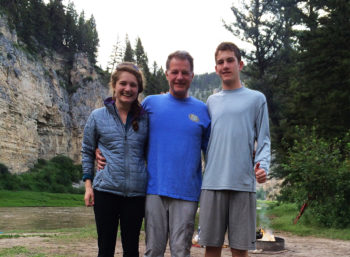
Mackenzie, K.C., and Henry Walsh
As both a Montanan and professional in the sport fishing industry, I hope that the recreational value of the Smith River corridor is clearly valued when our state agencies are evaluating the potential for mining at the headwaters of this beautiful resource.
When I read about the recent tragedy on the Animas River in Colorado, my first thought was that this might someday happen on the Smith. We just can’t let that happen, and it’s very hard to find examples of responsible mining projects that haven’t negatively impacted surrounding river systems.
It’s also hard to find mining projects that have provided a positive social result for the surrounding communities.
I am strongly opposed to the proposed copper mine along Sheep Creek in the Smith’s headwaters, and hope that we can find more sustainable opportunities to create jobs and economic vitality in White Sulphur Springs and the surrounding areas.
What You Can Do
Take action to help save the Smith River in Montana! Please urge Montana’s Governor Steve Bullock to protect this special place by directing his state agencies not to issue any permits for mining unless it can be developed in a manner that eliminates any possibility of degrading the river’s water quality and wild trout fishery.
There is a magical moment on every river trip when the group transforms into a tribe. It is at this moment that life away from the river is put on hold – when profession, politics, agenda fade in the background of your mind. Being on the river is what matters and sharing that experience with others regardless of background is what matters at the moment.
Often, this moment happens on the third night. At least it did on this years’ Yampa River Awareness Trip, a trip that American Rivers, Friends of the Yampa and OARS host every year on the Yampa River, the last wild river in the Colorado River Basin. This year’s trip, like others included 25 leading water policy experts representing a variety of interests. The purpose; to spend 5 days on the river to build good will, identify common ground, and talk about preserving the Yampa River for future generations.
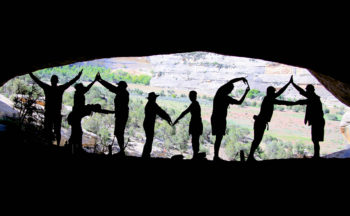
Having fun while camping on the Yampa
It is not to say that the group dynamic for the previous days and nights is awkward or uncomfortable, it is not. People are just getting to know one another, learning each other’s names, getting comfortable using a groover, etc.
In fact, the first night the group shared ceremonial beer supplied by Avery Brewing Company called “Collaboration not Litigation”. There is an interesting story behind this beer but you will have to go to the brewery to hear it. It was an appropriate way to start the trip as many of the participants sometimes find themselves on opposite sides of conference room tables when not on a river together.
On the 2nd day, there was a lot of good conversation, laughs, games, and a long hike but nothing like what went down on the third night. It started when a couple of members of the group snuck off, formed a band called Big Willy and The Debris Flow, and wrote a song titled the “Yampa River Blues” The song has dozens of verses, both written and improvised and by the third refrain “Let’s keep the Yampa Wild and Free”- we were a tribe. While music, goofy improvised songs and staying up late on the banks of a wild river is nothing new to river trips, that night we sang and laughed like it had never been done before.
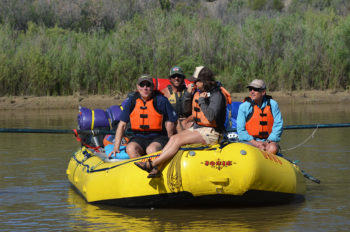
Paddling the Yampa River, CO
The Yampa River is better off for it. The river now has more influential friends that have experienced the magic of spending time together on a wild river.
This is a good thing as we continue to explore collaborative opportunities to permanently protect this river for fish and wildlife, recreation, and agriculture.
Special thanks to OARS for supporting this trip every year, to Chaco for providing Yampa Sandals for the group and to Avery for the delicious beer.
Tell us your story – what’s the greatest third night you’ve had around the campfire?
Today’s post is a guest blog by Susan Culp, our Verde River Coordinator.
And while many in Phoenix head up I-17 for the weekend to enjoy time in the cool pines of Flagstaff, there is also a hidden gem in the Verde Valley that some have come to love as an oasis from the hot summer days. Just a hop, skip, and a jump off the beaten path, lies one of Arizona’s last remaining perennial rivers and its cool, cottonwood-lined banks – the Verde River near Clarkdale and Camp Verde.
Many stretches of the Verde are perfect for canoeing, kayaking or SUP adventures, even in the peak of summer when the flows are at their lowest. The Verde River at Clarkdale, one of the most popular stretches among beginner and novice paddlers, has excellent river access points and flows through an amazing, intact riparian habitat with birds and wildlife galore for nature enthusiasts.
Clear Creek river access to Beasley Flats just southeast of the Town of Camp Verde, provides an easy launch point to a remarkable stretch of river. These sites, which are owned and managed by the Prescott National Forest, are also floatable through most of the summer. This stretch also tours through the beginning of the Wild & Scenic stretch of the Verde River, and offers a slightly more challenging and exciting paddle.
Unlike the bustling Lower Salt, these river stretches are relatively uncrowded, and the river communities are working hard to preserve their peace, solitude, and scenic beauty for all to enjoy, as well as terrific riparian wildlife habitat.
When you visit, please remember to be safe, and respectful of the river. Some tips for a great excursion to the Verde Valley include:
- Always wear a life jacket and never paddle alone.
- Be mindful with your consumption, as alcohol and boating don’t mix.
- Much of the land along the banks of the Verde River is private property. Please don’t trespass, and only seek out public access point to put in and take out.
- Practice Leave No Trace ethics, and pack out your trash.
River recreation and a healthy tourism economy around the vibrant river corridor is an important part of ensuring that the Verde River will continue flowing long into the future. Being a responsible steward of this remarkable Arizona treasure, and working together, will help preserve a flowing Verde River for generations to come. Enjoy!
Photo Credit: Doug Von Gausig, Verde River
As Hurricane Katrina rushed towards New Orleans the nation watched in horror as levees broke and water rushed in. We were even more outraged when we realized that this was no natural disaster- it was a failure of man. In 2006 American Rivers highlighted several of the ways man failed New Orleans and the Gulf in “Unnatural Disasters, Natural Solutions: Lessons From The Flooding of New Orleans.”
The flooding of New Orleans that followed was a tragic and appalling disaster. But it was not a natural disaster. Poor project planning, flawed project design, misplaced priorities, and the destruction of the city’s natural flood protection – Louisiana’s coastal wetlands, were the root causes of the city’s ruin. Each of these causes lies firmly within the hands of man.
Unnatural Disasters, Natural Solutions: Lessons From The Flooding of New Orleans.
The flooding of New Orleans was the direct result of over-engineering the Mississippi River and other flawed projects planned and designed by the Army Corps of Engineers. Levees and navigation projects destroyed coastal wetlands, interfered with the deposition of sediment needed to replenish coastal wetlands, and funneled the storm surge into New Orleans. To make matters worse, the Army Corps used flawed designs to build the levee and floodwall system that were supposed to protect the city.
One example of our hubris is the Mississippi River Gulf Outlet (MRGO). This little used, 76 mile long, deep navigation channel was cut through coastal marsh in 1965 to create a shortcut between the Mississippi River and the Gulf. The channel destroyed over 27,000 acres of wetlands and was dubbed a “hurricane surge super highway”. As Hurricane Katrina moved towards New Orleans, MRGO funneled the 20 foot wall of water toward communities, leveling levees and floodwalls and bringing catastrophic destruction.
Today, New Orleans and surrounding communities are making strides towards achieving their vision for a resilient Gulf Coast. MRGO was finally deauthorized and a surge barrier was constructed; the Army Corps recommended over $ 1.3 billion in restoration projects to Congress; and the State of Louisiana released the 2012 Coastal Master Plan which includes many of the ecosystem restoration projects. However much more needs to be done to cope with rising seas and increased storm intensity due to climate change, starting with funding for restoration projects. The MRGO Must Go Coalition recently outlined what is needed to build a resilient Gulf Coast in the report “10th Anniversary of Katrina: Making New Orleans a Sustainable Delta City for the Next Century”.
Preventing the Next Flood Disaster
There are three key changes that are needed to prevent the next flood disaster and achieve safer and healthier communities and rivers across the nation. These changes will be increasingly critical as climate change becomes more of a reality of our lives. Have we made any progress over the past decade?
Modernize the Army Corps of Engineers
The Army Corps’ project planning process is outdated and flawed which contributes to inadequate projects and environmental damage. Don’t take my word for it. The National Academy of Sciences, the Government Accountability Office, the Army Inspector General, federal agencies, and independent experts have all issued studies highlighting a pattern of stunning flaws in Army Corps project planning.
Hurricane Katrina shone a bright spotlight on these inadequacies and spurred Congress to make vital reforms. We celebrated in 2007 when Congress told the Army Corps to rewrite their project planning guidelines and again in 2014 when the Obama Administration released progressive new guidelines.
Unfortunately, Congress quickly forgot the lessons of Katrina. Bafflingly, over the past few years Congress has actually told the Army Corps they are forbidden from spending money to implement new and improved guidelines. The Army Corps continues to use outdated planning guidelines to plan water projects.
Adopt Natural Flood Protection
If the coastal wetlands in the Gulf had not been destroyed by canals, levees, and channels, they would likely have provided some degree of natural flood protection from Hurricane Katrina’s storm surge. Inland, natural flood protection can also be attained by maintaining healthy uplands and watersheds that slow the rate of runoff, protecting and restoring wetlands and floodplains, and by restoring a river’s natural flow and meandering channel.
Natural flood protection is slowly gaining a foothold across the country, but we have a long way to go before it is routinely the go-to choice for flood-prone communities. Many communities are making wise investments in natural flood protection like the innovative Floodplains by Design program in Washington state; building coastal resilience following Hurricane Sandy and improving infrastructure by upgrading undersized road-stream crossings in the Northeast; and investing in multiple-benefit floodplain restoration in California’s Central Valley.
The federal government has also made some changes that will encourage communities to look at natural flood protection choices in recent years. President Obama issued a new Federal Flood Risk Management Standard which requires federal agencies to consider nature-based approaches when investing in the floodplain and the 2015 Hazard Mitigation Assistance Guidance from FEMA allows for investment in “ecosystem-based or hybrid approaches to disaster risk reduction”.
Abandon Over-Reliance On Structural Protections Like Levees and Floodwalls
Structural flood “control” projects can cause severe environmental harm and when they fail the results can be disastrous. When a levee is constructed there is often a rush to develop behind them because people assume they will be safe. But levees only provide protection to a certain point. Floods can be higher than levees or erode away inadequate structures. When this happens levee failure can be fast and sudden, flooding development that may not have been built if the levee were never there in the first place.
That said, there is a lot of existing development in floodplains. Acquiring and restoring all the developed floodplain land in the nation would be an impossible task so levees and floodwalls are going to remain a tool in our flood risk reduction strategy toolbox. However, as we move forward, we need to do a better job making sure that these structures are the last option, only utilized once we’ve exhausted every other option. Improvements to the water project planning guidelines mentioned above are a good step in that direction, but we need the Army Corps to implement them to make real progress. Until they do, the drive for natural flood protection is going to have to come from communities and states that recognize that healthy rivers result in healthy, sustainable, and resilient communities.
Guest post by Deb Davidson, a resident of Bozeman, Montana. Deb escapes with her family to their cabin on the Smith River as often as possible.
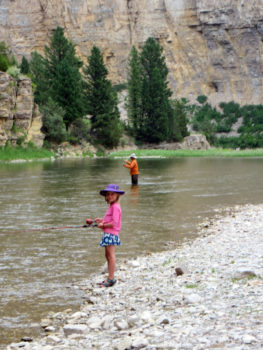
Learning to fish in our river
Twenty years ago, my parents bought a remote section of land perched above the Smith River, roughly 10 miles downstream from the Camp Baker put-in. The property is one of the highest points around, and from its towering limestone cliffs you can see the winding Smith River canyon, forests of old-growth ponderosa pine, and a variety of raptors soaring gracefully on hidden thermals.
The property did not have any buildings, so we decided to build a log cabin to serve as a family gathering place – and since my family likes to do things themselves and work hard, we built it ourselves.
For more summers than I can count, we met up at “the land” to live out of a wall tent and build this cabin. We hand dug foundation holes, peeled lodgepole pine logs, placed the logs, my husband built a timber frame, and we put a roof on. After many years of work we now have a beautiful cabin.
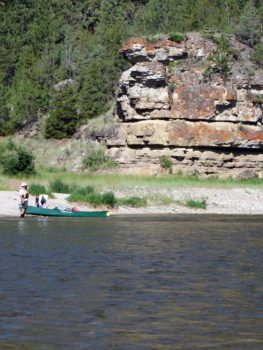
Enjoying the river
During those two weeks of work each summer we didn’t take much time off to play. But when we did, our reward was the mile-long hike down to the Smith River to fish, swim, and just relax.
Our place is not far from the Rock Creek campsite, so we would use that as a place to hang out, play, and catch some big trout in the deep hole along the cliff wall.
Rewarding ourselves on the Smith was a perfect way to relax and share friendship and love.
As we face a massive proposed copper mine at the headwaters of the Smith River, I encourage our decision makers to think about the importance of the Smith to Montanans like me, and have the courage to protect this special place.
I hope that we can look back on this period and say that our reward for denying the proposed mine is a cool, clean, free-flowing river that our families will be able to hike down to, float, swim, and fish for generations to come.
What you can do
Today, you can take action to help save the Smith River in Montana! Please urge Montana’s Governor Steve Bullock to protect this special place by directing his state agencies not to issue any permits for mining unless it can be developed in a manner that eliminates any possibility of degrading the river’s water quality and wild trout fishery.
“Flint” produced by Modoc Stories, celebrates the beauty and mysteries of Georgia’s Flint River.
It features three people – Robin McInvale, Jimmy Miller, and Paul DeLoach– and their special connections to the river. And, “Flint” continues our effort at American Rivers to use creative storytelling to inspire river conservation.
Their stories
Robin’s husband used to take her to the Upper Flint on fishing dates.
Four decades later the couple retreats to their riverside cabin most weekends to canoe and fish the waters they know as well as they know each other, introducing their grandchildren to their love of the Flint.
Jimmy Miller grew up fishing the lower Flint’s shoals and diving its freshwater springs. He has traveled the world and currently works stints on a schooner in the Atlantic and Caribbean, spending his off-time in a simple riverside cabin, and on the river, south of Albany’s Radium Springs.
Paul DeLoach is a pioneer among cave divers worldwide. He knows and loves the waters of the Flint River basin well, both above and below the surface, mapping the underground intricacies of the springs in most portions of the Floridan Aquifer in Georgia and Florida. One of the founders of Flint Riverkeeper, for decades he has been a leader in exploring and conserving the Flint’s waters.
Their river
Georgia’s Flint River provides water for over one million people, 10,000 farms, unique wildlife, and 300 miles of exceptional fishing and paddling. Despite being in a historically wet area of the country, in recent years many Flint River tributaries have dried up completely and the river’s flows have dropped dramatically.
American Rivers and Flint Riverkeeper are working in collaboration with diverse partners to restore the flows and health of the Flint.
Slow-moving blackwater. Untouched cypress vistas. Swallowtail kites and ospreys soaring overhead. Our new film features the many treasures of South Carolina’s Waccamaw River Blue Trail.
Come explore the Waccamaw with its extensive unique wetlands and wildlife habitat, rich history, and endless recreation opportunities. American Rivers helped launch the Waccamaw River Blue Trail in 2009 to improve recreation, increase community involvement, support conservation, and help citizens and decision makers embrace the river as a community asset.
Considered one of the finest blackwater rivers in the Southeast, the Waccamaw River is ideal for canoeing and kayaking and provides a memorable experience for all. Families enjoy paddling and watching otters and other wildlife. Anglers enjoy the year-round fishing. Birders visit to spot the red cockaded woodpecker, along with an abundance of herons and egrets.
Come explore, learn more, and plan your trip to the Waccamaw River Blue Trail!
The amount of impervious surface—those surfaces covered in concrete, buildings, etc.—in our communities can turn even an average rain event into cause for concern.
However, it is often more catastrophic events that serve as a wakeup call and spur change. In the wake of the flooding damage caused to the northeast by Hurricane Sandy, the federal government made funds available to help vulnerable coastal communities bolster their first line of natural defense – rivers and wetlands.
Healthy rivers and wetlands are like natural sponges. Wetland soils and plants can quickly trap and absorb rapidly increasing volumes of water. In fact, one acre of healthy wetlands can store 1 million gallons of water. Additionally, healthy floodplains often contain native vegetation and woody material that provide plenty of friction to slow storm surge and help alleviate the effects of flash flooding.
This summer and fall, American Rivers and several of our partners are working with the U.S. Fish and Wildlife Service, National Fish and Wildlife Foundation and others to increase natural resiliency in vulnerable areas by removing dams and restoring wetlands throughout the northeast.
Tidmarsh Creek, MA
In Massachusetts, American Rivers is pleased to be a part of the Tidmarsh Farms Restoration Project, which is the largest freshwater wetlands restoration project in the state. The area was once modified and flooded to create cranberry bogs. The project, which is being spearheaded by the Massachusetts Division of Ecological Restoration, will remove three dams, including Beaver Dam, and recreate a more natural floodplain in the headwaters areas. Specifically, the project team will reconstruct the stream channel, seed the area with extensive planting, and restore fish passage to a coastal pond and 3.5 miles of stream. Once complete, the area will boast 250 acres of healthy coastal wetlands, unobstructed stream miles for fish traveling from the ocean to spawning grounds in the headwaters, and diverse habitat for wildlife throughout the project site.
Centreville, MD
Despite its diminutive size, the Centreville Dam exacerbates upstream flooding on Gravel Run, threatening local businesses and the police station that is located along its impoundment. With climate change expected to increase the incidents of flooding in the area, American Rivers, the Town of Centreville and others are partnering to improve local flood resiliency by removing the dam and restoring the natural stream channel and surrounding habitat. In addition to alleviating some upstream flooding, removal of the dam will provide access to additional upstream habitat for river herring and other native fish.
Musconetcong River, NJ
The Musconetcong River has been an important resource in the Delaware River Basin since at least the 1600s. American Rivers has partnered with the Musconetcong Watershed Association for several dam removals along its length in prior years, and we’re excited to continue the work this fall. The goal of this project is to remove the Hughesville Dam and revitalize 6.95 miles of habitat just upstream of the Musconetcong’s confluence with the Delaware River. The second, forthcoming phase of this project will remove the next upstream dam, the Warren Glen Dam, in order to add five additional free-flowing river miles. Once complete, the Musconetcong will have a total of 30 river miles under the Wild and Scenic designation.
West River, CT
Originally built in 1794, the Pond Lily Dam currently presents a flood hazard two ways. Not only is it an impediment to natural stream flows and healthy habitat, but the dam is in disrepair and at high risk of failure. The Pond Lily Dam is also a barrier for migratory fish in the West River. Removing it will allow the Connecticut Fund for the Environment to help restore access to 2.6 miles of habitat on the West River as well as 76 acres of Konold’s Pond habitat for native species like alewife and blueback herring, as well as peace of mind to its neighbors.
